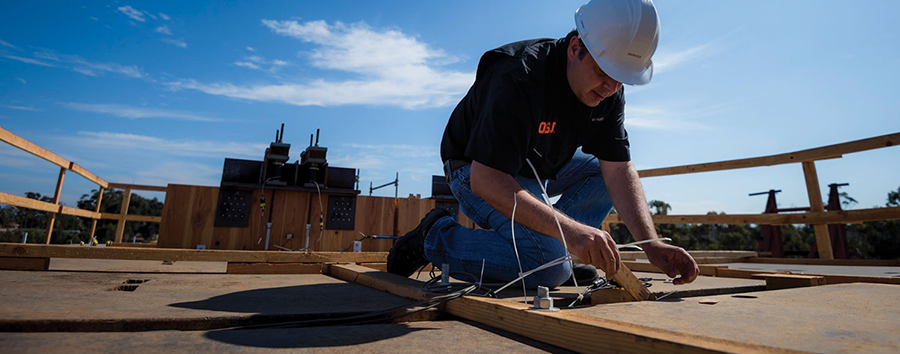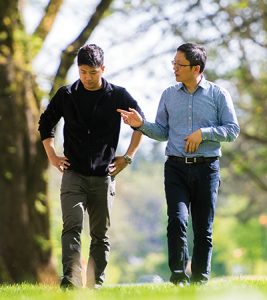
The use of herbicides in forests is a controversial topic in Oregon, throughout the country and the world. For the past eight years, Oregon State professor of landscape and wildlife ecology Matthew Betts and his research team have studied them closely, in a study partially funded by the college’s Institute for Working Forest Landscapes. The research team paid close attention to the effects on wildlife and timber production.
“This study is relevant locally because herbicide use is commonly-used on Oregon Department of Forestry and industrial lands,” Betts says. “In the Pacific Northwest, it’s the primary silvicultural method that follows clearcutting.”
Betts says the topic is becoming relevant globally as herbicides become more popular in plantation forests worldwide. Currently, about 35 percent of timber comes from plantations, and in the next 50 years, experts project that most timber will come from this source. Betts believes now is the time for forest managers to have adequate scientific information to inform decisions about whether or not to use herbicides.
His study on intensive forest management is the largest of its kind in the world. The research team worked together with industry and the State of Oregon to study 32 stands of 15 acres or more with four different levels of herbicide treatments ranging from no treatment at all in the control group through more heavily treated stands similar to those in a commercial setting, and an extreme treatment that exceeds current spray practices.
Stands that have or haven’t been treated with herbicides can usually be recognized based on the amount of vegetation growing at the foot of young forests whose canopies haven’t yet closed. Untreated forests tend to have green floors, whereas heavily treated forest floors are initially quite bare.
Eight years into the experiment, Betts says the saplings they started with are huge in relative terms. The research team has also learned how herbicides affect various species of plants and animals within the forest.
“There’s little doubt that on the timber side, trees grow faster when herbicides are sprayed,” Betts says. “Our study shows that the most heavily sprayed stands produce up to 30 percent more volume, but there is an effect on biodiversity.”
The study measured herbaceous plants, birds, pollinators such as bees, deer, elk, moths and other insects.
“There were more bird species in areas where we didn’t spray herbicides,” Betts says. “Wilson’s Warbler was one of the most affected species. We also saw depressed numbers of pollinators. Surprisingly, we did not detect much of a change in populations of deer, elk and moths.”
Betts says that around year five of the study, for the most part, the number of species began to equalize and recover.
“Even the heavily-sprayed stands began to turn green,” he says. “In the end, some species responded negatively, some species have been resilient and some responded negatively and then recovered.”
Land managers pay up to $200- 250 per acre for herbicide spray. Money is spent up front and not returned until stands are harvested at age 40-50.
On the economic side of the study, the research team concluded that herbicide isn’t cheap, and that spraying does not always generate additional financial value.
“You could spend $250 per acre now, or invest that money in a bank somewhere. If your expectation is a financial yield of seven percent or greater, we’ve found that it doesn’t make economic sense to spray, all other things being equal,” says Betts.
He emphasizes the study saw no failed stands or plantations, and valuable biodiversity tended to increase without herbicide use. The research team will continue to monitor the stands up to the 15-year mark when the canopy will start to close, limiting sunlight to shrub species. They also plan to survey the general public about aspects of the study and perceptions about herbicide use.
That’s where Mark Needham, Oregon State professor of social science, policy and natural resources, comes in.
“We began surveying in early 2019,” Needham says. “We’re focusing on a number of small, rural communities in the coast range near the stands in the study. We plan to ask residents about their knowledge, attitudes and perceptions associated with the herbicide issue. We hope to survey at least 400 people.”
Instead of asking one-off questions, Needham says that in this context, it’s important for survey respondents to make tradeoffs and prioritize their interests.
“This study spans so many different areas including wildlife, soil, water, pollinators and economic impacts, so it’s important to make sure we look at the tradeoffs people are willing to make within the context of herbicide use,” Needham says.
Betts agrees land managers and the general public need to decide if they want forests with more biodiversity but less timber growth per acre, or less biodiversity and high rates of timber production.
“Without spray,” he offers, “you need to spread out forestry operations to get the same amount of lumber. With spray, you have more tightly-packed and intensely managed stands, which can potentially free up land for conservation.”
Betts realizes these are hard decisions. “The results of this study are just not as straightforward as we expected them to be,” Betts says. “We hope this science will help managers and the public make educated decisions about herbicide use amid the controversy.”




















 Cable-assisted harvesting systems are gaining popularity in the Pacific Northwest. Stewart Professor of Forest Operations
Cable-assisted harvesting systems are gaining popularity in the Pacific Northwest. Stewart Professor of Forest Operations